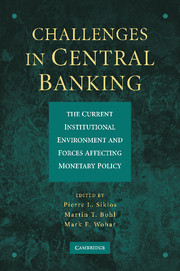 Challenges in Central Banking
Challenges in Central Banking Published online by Cambridge University Press: 06 December 2010
Abstract
In this survey, we present a number of arguments that question some aspects of the conventional view of central bank independence (CBI). We argue that CBI is neither necessary nor sufficient for reaching monetary stability. First, CBI is just one potentially useful monetary policy design instrument among several. Second, while the relevant economic theories focus on the aspect of goal independence, in practice most central banks tend to be only instrument independent. Third, CBI should not be treated as an exogenous variable, but attention should be devoted to the question of why central banks are made independent. CBI is chosen by countries under specific circumstances, which are related to their legal, political, and economic systems. Fourth, in a number of empirical studies, researchers found CBI to be correlated with low inflation rates. By taking the endogeneity of CBI into account, however, there remains little reason to believe the correlation between CBI and low inflation tells us anything about causality.
Introduction
Central bank independence has become one of the central concepts in monetary theory and policy. Most economists agree that CBI is desirable because it helps to reach the long-term goal of price stability. Although one might think about alternative mechanisms to reach low rates of inflation, CBI is the one most-often recommended. The idea has also found confirmation in the fact that an increasing number of countries in all regions of the world made their central banks independent in the last 20 years (Arnone et al. 2007; Cukierman 2007).
To save this book to your Kindle, first ensure [email protected] is added to your Approved Personal Document E-mail List under your Personal Document Settings on the Manage Your Content and Devices page of your Amazon account. Then enter the ‘name’ part of your Kindle email address below. Find out more about saving to your Kindle.
Note you can select to save to either the @free.kindle.com or @kindle.com variations. ‘@free.kindle.com’ emails are free but can only be saved to your device when it is connected to wi-fi. ‘@kindle.com’ emails can be delivered even when you are not connected to wi-fi, but note that service fees apply.
Find out more about the Kindle Personal Document Service.
To save content items to your account, please confirm that you agree to abide by our usage policies. If this is the first time you use this feature, you will be asked to authorise Cambridge Core to connect with your account. Find out more about saving content to Dropbox.
To save content items to your account, please confirm that you agree to abide by our usage policies. If this is the first time you use this feature, you will be asked to authorise Cambridge Core to connect with your account. Find out more about saving content to Google Drive.